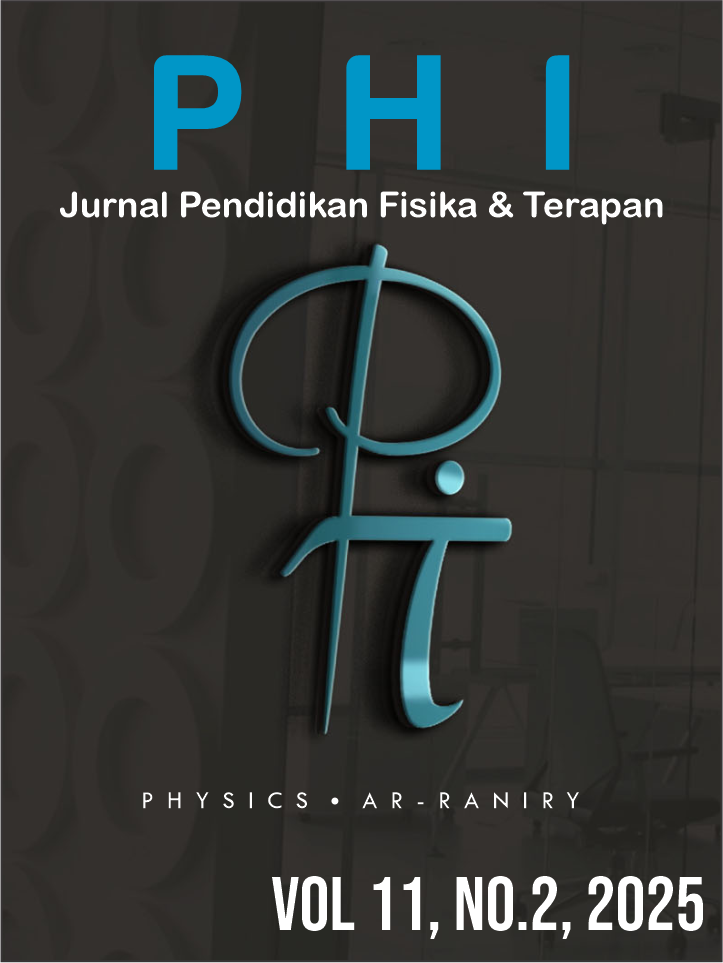Effect of Aluminium Plate Layers and Electric Current on Pendulum Damping Time
DOI:
https://doi.org/10.22373/t56y9778Keywords:
electric current, eddy current, aluminium, braking timeAbstract
The pendulum is a classic oscillatory system commonly used in physics to study motion and damping phenomena. One notable damping mechanism is electromagnetic damping caused by eddy current induction. This study investigates the effects of varying the number of aluminium plate layers attached to the pendulum and the electric current supplied to a surrounding coil, which generates a magnetic field, on the pendulum damping time. An experimental approach was used by measuring the damping time across different combinations of plate layers and current levels. The data were analyzed to identify the relationship between these variables and the damping behavior of the pendulum. Results indicate a negative exponential relationship between the electric current and damping time, as well as a significant effect of aluminium plate layers on damping efficiency. Increasing the number of aluminium plate layers enhances eddy current induction, resulting in stronger damping forces.
References
Budiarto, D. P., Athoillah, M. J. S., & Noerpamoengkas, A. (2022). Pengaruh Jarak Magnet-Pelat Tembaga dan Grade Magnet terhadap Respon Tunak Sistem Getaran dengan DVA Berperedam Arus Eddy (Pelat Grounded dan Magnet pada Massa DVA). Prosiding Seminar Nasional Sains Dan Teknologi Terapan.
Chen, C., Xu, J., Yuan, X., & Wu, X. (2019). Characteristic Analysis of the Peak Braking Force and the Critical Speed of Eddy Current Braking in a High-Speed Maglev. In Energies (Vol. 12, Issue 13). https://doi.org/10.3390/en12132622
Dolfo, G., Castex, D., & Vigué, J. (2016). Damping mechanisms of a pendulum. European Journal of Physics, 37(6), 65004.
Fahriani, V. P., Setiawan, R., & Pertiwi, S. R. (2019). UJI EXPERIMEN VARIASI BAHAN FEROMAGNETIK INTI LOGAM DAN INDUKTOR. JITEKH, 7(2), 22–28.
Firmansyah, J., Wibisono, G., & Mahendra, A. D. (2024). PERANCANGAN EDDY CURRENT BRAKE PENGGUNAAN ALUMINIUM UNTUK SISTEM PENGEREMAN SEPEDA MOTOR LISTRIK. TIEKOM: Scientific Research Journal, 1(1), 52–62.
Ghifari, M. R., Agung Pramono, R., & Nur Aziz, K. (2023). Aplikasi Gaya Magnet Pada Fenomena Osilasi Teredam Dalam Sistem Gerak Harmonik Sederhana. Jurnal Penelitian Fisika Dan Terapannya (JUPITER), 5(1), 16–22. https://doi.org/10.31851/jupiter.v5i1.11839
Griffiths, D. J. (2023). Introduction to Electrodynamics (5th ed.). Cambridge: Cambridge University Press.
Janzen, D. (2018). Introduction to Electricity, Magnetism, and Circuits. University of Saskatchewan, Distance Education Unit.
Noerpamoengkas, A., & Ulum, M. (2022). Studi Eksperimental Pengaruh Posisi Menyudut Pendulum-Pelat Tembaga pada Getaran Pendulum Berperedam Arus Eddy. Semesta Teknika, 25(2), 89–99. https://doi.org/10.18196/st.v25i2.13455
Pain, H. J. (2005). The Physics of Vibrations and Waves. Chichester: John Wiley & Sons.
Pili, U. B. (2020). Modeling damped oscillations of a simple pendulum due to magnetic braking. Physics Education, 55(3), 35025.
Putra, D. P., Darmawan, N. A., & Noerpamoengkas, A. (2022). Studi Eksperimental Pengaruh Tebal dan Jenis Magnet terhadap Respon Peralihan Pendulum Berperedam Arus Eddy. Seminar Nasional Sains Dan Teknologi Terapan X, 1–7.
Reitz, J. R., Milford, F. J., & Christy, R. W. (2009). Foundations of Electromagnetic Theory. Pearson Education.
Sa’adah, N., Jumaeri, Putri, W. B. K., Munazat, D., & Kurniawan, B. (2020). Sifat Magentik Material La0,6Ba0,4MnO3 dari LaMnO3 dan BaMnO3 Menggunakan Metode Kombinasi Sol-Gel dan Solid State. Indonesian Journal of Chemical Science, 9(1), 44–47.
Serway, R. A., & Jewett, J. W. (2014). Physics for Scientists and Engineers with Modern Physics 9th Edition. Boston: Cengage Learning.
Sodano, H. A., & Bae, J.-S. (2004). Eddy current damping in structures. Shock and Vibration Digest, 36(6), 469.
Suwarno, D. U. (2015). Getaran osilasi teredam pada pendulum dengan magnet dan batang aluminium. Prosiding SKF, 100–107.
Suwarno, D. U. (2016). Alat Peraga Efek Arus Eddy Dengan Menggunakan Piringan Magnet Berputar. PROSIDING SNIPS, 268–274.
Thornton, S. T., & Marion, J. (2004). Classical Dynamics of Particles and Systems. Belmont: Thomson Learning.
Tipler, P. A. (2001). Fisika Untuk Sains dan Teknik Jilid 2 (Terjemahan) Edisi 3. Jakarta: Erlangga.
Wahyuni, S., Erwin, E., & Salomo, S. (2015). Analisa Pengaruh Inti Koil Terhadap Medan Magnetik Dan Muatan Pada Kapasitor Dalam Rangkaian Seri Lc. Jurnal Online Mahasiswa Fakultas Matematika Dan Ilmu Pengetahuan Alam Universitas Riau, 2(1), 79–85.
Wang, T. (2023). Pendulum-based vibration energy harvesting: Mechanisms, transducer integration, and applications. Energy Conversion and Management, 276, 116469.
Wiranto, I. (2024). KINEMATIKA GERAK. In Mekanika Dasar (p. 22). CV. Gita Lentera.
Zarkacy, M. I., Prakasa, F. R. M., & Noerpamoengkas, A. (2023). Studi Eksperimental Respons Tunak Getaran Model Bangunan Akibat Variasi Panjang Pendulum dan Jarak Celah Pelat Tembaga pada Eddy Current Pendulum Pounding Tuned Mass Damper. Prosiding SENASTITAN: Seminar Nasional Teknologi Industri Berkelanjutan, 3.
Zulaikha, D. F., & Warsono. (2021). Aplikasi Transformasi Laplace pada Sistem Dinamik Pendulum Terbalik dengan Redaman dan Gaya Penggerak. Jurnal Pendidikan Fisika, 9(1), 1. https://doi.org/10.24252/jpf.v9i1.18659
Downloads
Published
Issue
Section
License
Copyright (c) 2025 Khawarizmy Mahfudz, Yudhiakto Pramudya

This work is licensed under a Creative Commons Attribution-NonCommercial 4.0 International License.
Authors who publish with Jurnal Phi agree to the following terms:
- Authors retain copyright and grant the journal right of first publication with the work simultaneously licensed under a Creative Commons Attribution License (CC BY 4.0) that allows others to share the work with an acknowledgment of the work's authorship and initial publication in this journal.
- Authors are able to enter into separate, additional contractual arrangements for the non-exclusive distribution of the journal's published version of the work (e.g., post it to an institutional repository or publish it in a book), with an acknowledgment of its initial publication in this journal.
- Authors are permitted and encouraged to post their work online (e.g., in institutional repositories or on their website) prior to and during the submission process, as it can lead to productive exchanges, as well as earlier and greater citation of published work (See The Effect of Open Access).

















